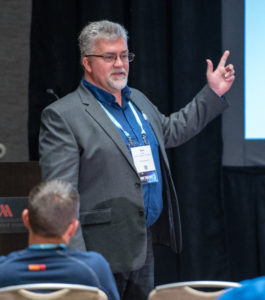
AclaraConnect 2019 registration is open. This unique conference, being held at the Fairmont Hotel in Austin Texas, May 20-23, 2019, is where leaders, innovators, and people who make things happen gather to learn about the latest in electric, water, and gas utility industry and share the secrets to success.
Still deciding whether to attend? Trying to convince your boss? Here’s a recap of 4 great sessions from last year’s conference that can help make the case to attend.
1: A Rural Electric Co-Op’s Approach to Monitoring and Managing Today’s Grid
Phillip Amaya, technical services division manager at Magic Valley Electric Cooperative in Texas, outlined how the evolving nature of today’s grid requires electric utilities to build secure and future-proof distribution networks. Amaya informed attendees that a successful smart grid project was more than a technical effort and that distribution automation required:
- An understanding that the end results would support the utility’s mission of providing a reliable service at an affordable cost.
- Cooperation across the organization – accounting, analysts, and operations – to help engineering put together a successful plan. and they all came together and helped us put together a successful plan
- Deciding whether the project would be conducted by operations or information technology organizations.
- Smart decisions to invest in technologies that could be scaled to meet future requirements
2: Are You Ready for Calamity?
When Hurricane Sandy struck the East Coast of the U.S. in 2012, it left large areas of the most populous areas of the country devastated. In this session, Michael Roach, a manager in the Technical Services Division of the New York Department of Protection, discussed how the department helped other agencies track the progress of evacuations in hard-hit areas of New York while still collecting 90% of reads from their AMI systems.
Some lessons from the storm:
- Coordinate with surrounding areas pre-calamity in case they have additional resources that can help when storms strike
- Prepare sewage treatment plants to operate further into the storm and communicate to residents to limit flushing
- Make sure residents in evacuation areas know the importance of leaving to the restoration of services.
For more information on New York’s response to Hurricane Sandy, read the case study.
Need more information to convince your boss? Check out these 5 additional takeaways from last year’s AclaraConnect.
3: How NV Energy Went from Load Monitoring to Fault Location with Smart Grid Sensors
 Nevada is a large state with large service territories that can extend across thousands of miles of rugged terrain. NV Energy, the utility company that serves the state, must monitor the electric lines that crisscross it to maintain situational awareness. of conditions on the grid.
Nevada is a large state with large service territories that can extend across thousands of miles of rugged terrain. NV Energy, the utility company that serves the state, must monitor the electric lines that crisscross it to maintain situational awareness. of conditions on the grid.
Ron Kirker, senior engineer for distribution planning, told attendees that the utility typically gained situational awareness of grid conditions using traditional telemetry solutions. These paper chart recorders or analog meters were read manually by personnel that must drive to remote locations to manually record data from the monitoring equipment on log sheets. Engineers entered the data into spreadsheets that were used by various departments to make planning and operations decisions.
Kirker explained that he had to replace this antiquated system, but telemetry upgrades weren’t feasible due to costs and a budget timetable that would have extended the project out 35 years. According to Kirker, smart grid sensors – which cost a fraction of the telemetry system – not only replaced the functionality provided by the utility’s telemetry solution but also identified precursors to faults.
To learn more, read the case study How to Monitor Your Distribution Network.
4: The Empowered Consumer: Understanding the Consumer Perspective
Nathan Shannon, deputy director of the Smart Energy Consumer Collaborative (SECC) shared results from the organization’s Empowered Consumer research report. This report, available only to members of the SECC, looked at the ways in which smart grid programs enable consumers to understand how they are using electricity, gas, and water. The SECC found that there are 4 primary types of consumers:
- Green champions comprise about 30% of the U.S. population and are motivated by environmental concerns and clean energy
- Low-income consumers, another 30% of the population, are concerned with how to control their energy use and budget for their monthly bills
- Status quo consumer, about 18% of the population, live in smaller homes and have low energy bills and are not interested in communications from their utilities.
- An additional group of consumers live in high-income areas and tend to be new adopters of technologies and are open to choosing new ways of controlling energy use.
What attendees learned was that it is critical for utilities to understand their consumers and target market energy programs to them. learn more about the SECC and its research programs here.
